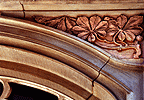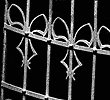Erected for a choral society
(1), this
building hosts a large concert hall (1500 seats) and several rooms for other choral and musical societies, including a restaurant.
A the end of World War I, it was put up for sale and finally bought by the city in 1922.
This edifice was one of the first to get a structure made of reinforced concrete (Hennebique proceed).
The decorative choice for the façades reveals the architects hesitation. For instance, the corner
tower has a gothic look (apart from the roof) and is fitted with art nouveau
windows and gets panels with a floral pattern at the upper level. The
posts that fit the balustrade of the balcony at the 2
nd floor show a geometric decor that evokes the works of the belgian architect Hamesse or the viennese art nouveau. For the lateral (and asymetric)
façades, Kuder & Muller opted, at least for the gable, for a renaissance style. One of the
doors, rue Sellénick, is art nouveau. The
wrought iron that protects the windows looks somewhat like that used for the Waucquez stores in Brussels (by Horta). Again, the art nouveau is questioned by a neo-renaissance windows that surmounts this entrance.In some other cases, art nouveau elements are more skillfully
integrated to an historistic
group. Last, but not least, some
windows are without controversy art nouveau
The inside also witnesses that stylistic variety. In this way, the music-lover will go to the concert hall (originally neo-baroque) by climbing an art nouveau
stair, as well as he may see in some other rooms
woodworks, a
door handle or
window fittings
(2) in the style we like so much. Don't forget to give a glance to all the stair
banisters. The
coat racks also figur a compromise solution:
an art nouveau body with hooks supported with historistic
mascarons.
This building, witnesses the architects desire to integrate it within its architectural environment (n°
s 1, 3, 5 & 6 rue Sellénick are art nouveau, the others belonging to the historicism). Therefore, their stylistic hesitation not only evidences the necessity to care for their customer but also their interest for the latest artistic movement. Nevertheless, the location (a street corner) offers an opportunity to put a strong signal (the tower) in order to distinguish the building from its neighbouring.
As a conclusion, in spite of some clumsiness, the architects have given to that edifice an engaging look, and it is worth to be preserved.
(1) The "Strassburger Männer-Gesangverein", founded in 1872.
(2) The latter one is an industrial product which we have also found in another house.
Bibliography:
- Adressbuch der Stadt Stra-burg, 1905
- BAGINSKI M. Autour de 1900 in Bulletin de la Faculté des Lettres de Strasbourg, may-june 1968, pp. 757-759
- PERILLON M.-C. Clins d'oeil 1900 à Strasbourg in La Maison d'Alsace, mai-juin 1977, pp. 47-58.
- LAUGEL A. Chronique d'art décoratif in Revue Alsacienne Illustrée, 1903, V, pp. 61-63.





























